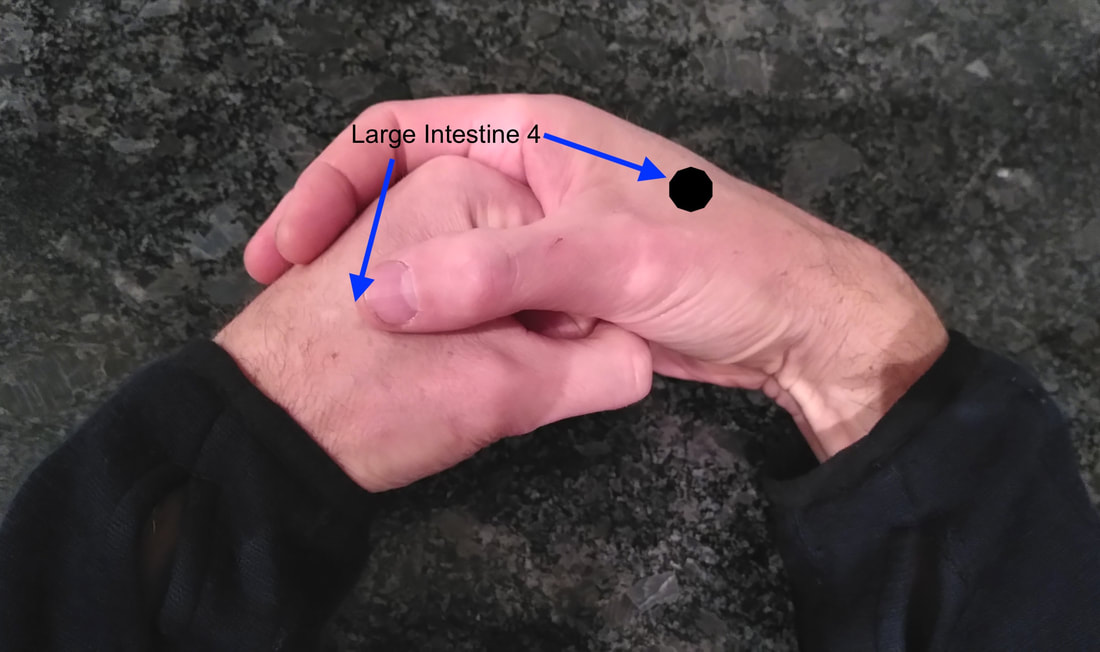
What first drew me to study Chinese Medicine or more specifically Acupuncture and Tui Na massage, the 2 bodywork methods of Chinese Medicine, is that you have it all on your own body. I can be anywhere, at any point in time and if I feel some sort of symptom coming on, such as a headache, I could press an Acu-Point on my own body to relieve it. This does not mean that the symptom may completely disappear, as it may be that I have to change the environment or situation that I am in, in order that the headache can dissipate completely. But being able to press a point on my own body to relieve the pain, till I can alter the space that I am in, is quite empowering.
The Chinese call Acupuncture, 針灸 Zhēn Jiǔ,which actually refers to both Acupuncture and Moxibustion. The Zhēn character has a metal or gold character on the left, which also contains the character for Earth, 土 Tǔ, and threading a string through a hole of a needle on the right. Jiǔ has the Fire character below and above the phonetic character to create the sound Jiǔ. In English, the word "Acupuncture" first presents itself in the late 17th century; a combination of Latin for needle, acus, and punctura, pricking. This is most probably a description from observations from Western physicians who traveled East Asia at that period in time. As you read these two descriptions of what we call Acupuncture in the West, you come to realise that the Chinese refer to more than just the "pricking of needles" when it comes to Acupuncture. They are referring to the elements of Metal, Earth and Fire coming together, with precision of "threading a needle." Moxibustion is performed with the burning of the plant Artemisia vulgaris on or by an Acu-Point. For me this incorporates the elements Metal, Earth, Fire and Wood. If you have ever had direct Moxa, you will also have had Water being used to moisten the skin. Hence, all of the 5 Elements are being incorporated into a treatment.
Even the translation for the word Acupuncture Point is not the same as what the Chinese understand. As Ellis, Wiseman and Boss explain:
'The word "point" indicates a linear coordinate, i.e., the intersection of two lines, a dot on the skin suitable for the insertion of needles or the application of some other stimulation. The Chinese character for acupuncture point, 穴 xuè, brings to mind a "cave" or "hole." The meaning is clear from the two parts of the character: the top portion represents a roof, while the bottom portion is a character on its own, meaning to divide or remove. The combined meaning of the two parts is a dwelling that is made by removing dirt or rocks, i.e., a cave, a hole, a den.' (Ellis, Wiseman, Boss, 1989)
In the West, students of Chinese Medicine are taught the names of Acu-Points with an association to an organ and a number, for instance Large Intestine 4 (LI-4). In the Chinese-speaking world, students are taught in traditional names, some a thousand years old, depending on the lineage that their teacher holds. The Acu-Point I mentioned before, LI-4, is named 合谷 Hé Gŭ in Chinese, meaning Union Valley. As you can already observe from this name, there is an image of a valley where two mountains unite. One interpretation of this name is that it refers to the location of Hé Gŭ, between the "mountains" of the thumb and the index finger, where there is a valley-like depression.
This Acu-Point is on the Large Intestine channel, as such it will treat issues with digestion like diarrhea. It is also used to treat headaches as it is the control point of the head, regulating the face, eyes, nose, mouth and ears, as well as pain in other parts of the body. It also helps in treatment of colds and flus. One other very special indication is that it induces labour or stimulates uterine contractions to aid in menstrual cramps. Hé Gŭ is also what we call a Yuan-Source Point; it is one of the Acu-points in a category of points that hold the Source of Qi for its designated organ channel. As you may have observed from its indications, this is a special Acu-Point that is used often as it can have profound effects on many parts of the body.
You can locate this Acu-Point by making a fist with one hand and covering the fist with your other hand cupped over, as in the image. Where the thumb of the top hand lands is where Hé Gŭ is located. This is the called the "palm-hold-fist" greeting, the way many Chinese people greet others since thousands of years. When you press on this Acu-Point you will feel a sensation that is stinging or heaviness, which is the stimulation that you want to have in order to affect the body.
I find pressing Acu-Points on my own body a very good way to be connected to my being. The points do not always manifest the same sensation, as our bodies are in constant flux within and with our environment. Try finding Hé Gŭ on yourself, begin your own journey to yourself.
Reference
Ellis, Andrew / Wiseman, Nigel / Boss, Ken (1989): Grasping the Wind. Brookline, MA, USA: Paradigm Publications
Image Mountain Lake by GSquare on Pixabay
Image Palm-Hold-Fist by Elaine


 RSS Feed
RSS Feed